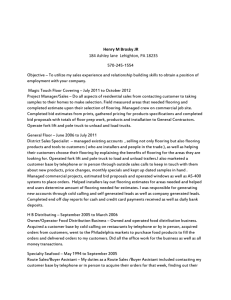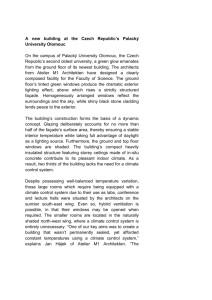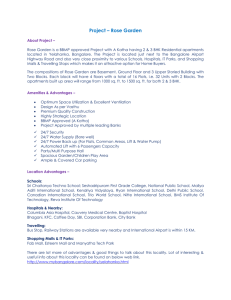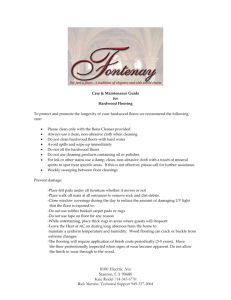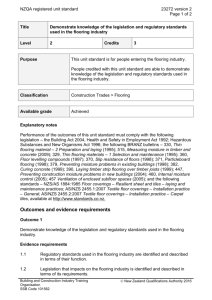Effects of Flooring on Animal Health and Well-Being
advertisement
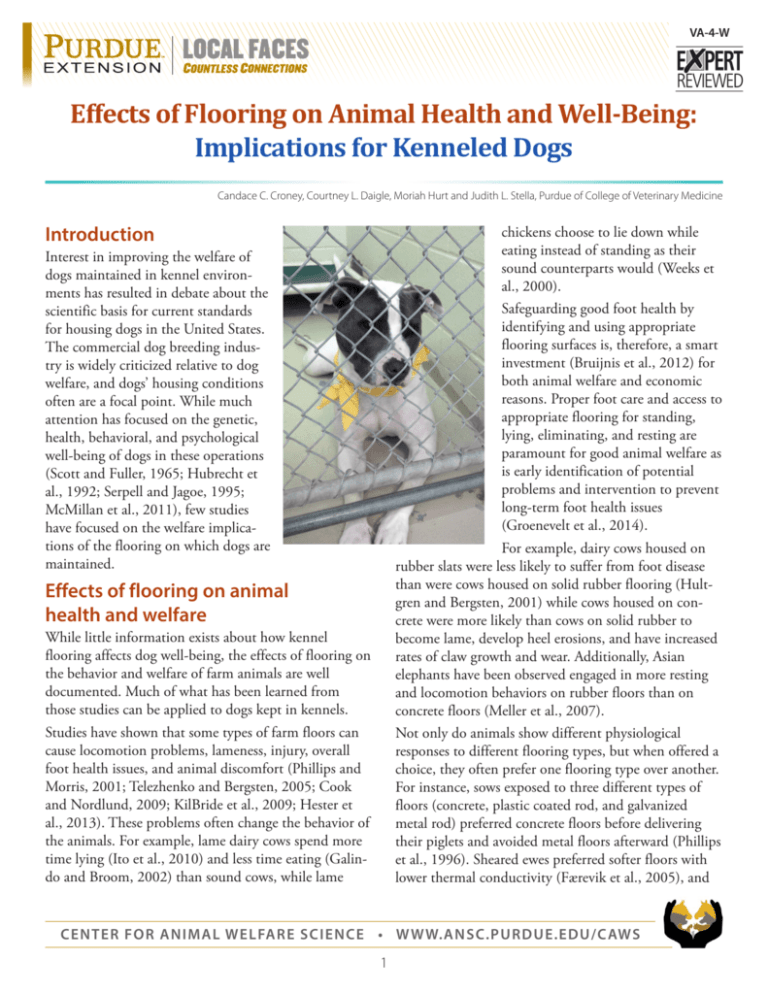
VA-4-W Effects of Flooring on Animal Health and Well-Being: Implications for Kenneled Dogs Candace C. Croney, Courtney L. Daigle, Moriah Hurt and Judith L. Stella, Purdue of College of Veterinary Medicine Introduction chickens choose to lie down while eating instead of standing as their sound counterparts would (Weeks et al., 2000). Safeguarding good foot health by identifying and using appropriate flooring surfaces is, therefore, a smart investment (Bruijnis et al., 2012) for both animal welfare and economic reasons. Proper foot care and access to appropriate flooring for standing, lying, eliminating, and resting are paramount for good animal welfare as is early identification of potential problems and intervention to prevent long-term foot health issues (Groenevelt et al., 2014). For example, dairy cows housed on rubber slats were less likely to suffer from foot disease than were cows housed on solid rubber flooring (Hultgren and Bergsten, 2001) while cows housed on concrete were more likely than cows on solid rubber to become lame, develop heel erosions, and have increased rates of claw growth and wear. Additionally, Asian elephants have been observed engaged in more resting and locomotion behaviors on rubber floors than on concrete floors (Meller et al., 2007). Not only do animals show different physiological responses to different flooring types, but when offered a choice, they often prefer one flooring type over another. For instance, sows exposed to three different types of floors (concrete, plastic coated rod, and galvanized metal rod) preferred concrete floors before delivering their piglets and avoided metal floors afterward (Phillips et al., 1996). Sheared ewes preferred softer floors with lower thermal conductivity (Færevik et al., 2005), and Interest in improving the welfare of dogs maintained in kennel environments has resulted in debate about the scientific basis for current standards for housing dogs in the United States. The commercial dog breeding industry is widely criticized relative to dog welfare, and dogs’ housing conditions often are a focal point. While much attention has focused on the genetic, health, behavioral, and psychological well-being of dogs in these operations (Scott and Fuller, 1965; Hubrecht et al., 1992; Serpell and Jagoe, 1995; McMillan et al., 2011), few studies have focused on the welfare implications of the flooring on which dogs are maintained. Effects of flooring on animal health and welfare While little information exists about how kennel flooring affects dog well-being, the effects of flooring on the behavior and welfare of farm animals are well documented. Much of what has been learned from those studies can be applied to dogs kept in kennels. Studies have shown that some types of farm floors can cause locomotion problems, lameness, injury, overall foot health issues, and animal discomfort (Phillips and Morris, 2001; Telezhenko and Bergsten, 2005; Cook and Nordlund, 2009; KilBride et al., 2009; Hester et al., 2013). These problems often change the behavior of the animals. For example, lame dairy cows spend more time lying (Ito et al., 2010) and less time eating (Galindo and Broom, 2002) than sound cows, while lame CENTER FOR ANIMAL WELFARE SCIENCE • W W W.ANSC.PURDUE.EDU/C AWS 1 Effects of Flooring on Animal Health and Well-Being: Implications for Kenneled Dogs chickens raised on either litter or wire mesh preferred litter over mesh when given the choice (Dawkins, 1983). These studies demonstrate that animals have preferences for flooring surfaces, and these may change depending on the environment or situation. Concrete and PVC-coated, diamond-shaped wire mesh flooring are common flooring materials used by commercial dog breeders, distributors of dogs, and retail pet stores. These types of flooring are often used in laboratory settings as well. Surprisingly, however, few studies appear to have examined the effects of these or any flooring surfaces on dog behavior, health, and overall well-being. Consequently, although some groups oppose the use of coated wire flooring for long- and even short-term housing of dogs, the basis for mandating for or against them seems ambiguous at best. Only one study (Kovacs et al., 2005) has examined the relationship between flooring and any aspect of dog health. However, assessing the effects of flooring was not the focus of the study; instead, flooring was only one of many factors that appeared to contribute to interdigital interdigital cysts in adult beagles. While the occurrence of cysts increased as dogs spent more time on every type of flooring evaluated (PVC-coated wire mesh floors; flat bar steel, uncoated; and flat bar, PVC-coated), the occurrence of cysts was lowest (8%) in dogs kept on PVC-coated wire mesh. At first glance, this might appear to contradict objections to coated wire mesh flooring, but a more comprehensive examination of the effects of this material on dog foot health, along with other commonly used surfaces, is essential before conclusions and recommendations can be made as to their suitability for dogs in both the short- and long-term. Understanding the impacts of flooring to improve dog behavior and welfare To ensure dog welfare, the flooring chosen for housing of dogs must meet several key criteria. It should allow the dog to separate itself from its excrement, be safe and comfortable for lying, standing, walking and eliminating, and it should be easy to clean. Dogs confined in an enclosure may spend more time with their feet in contact with urine and feces than they would if not confined. Even when excrement is removed daily, a porous kennel floor may become saturated with urine due to repeated use. When the dog walks on the same surfaces used for urination and defecation, the animal’s feet are exposed to these irritants more often than would normally happen. Prolonged exposure of this kind may cause foot health problems. Thus, improper flooring can create unwanted foot health issues (Webb and Nilsson, 1983) that may cause pain and compromise dog welfare. Safe and species-appropriate flooring is therefore paramount for good foot health. Dogs, like other animals, can slip and fall on uneven or slippery surfaces (Grandin, 1996; Weeks et al., 2002), and the texture of the flooring may impact gait (Flower et al., 2007) as well as foot wear and tear (Newton et al., 1980). Additionally, a surface’s material, slope, texture, and finish all affect the animals’ comfort and health. If the flooring is difficult to walk on, a dog may alter its gait in adaptation, and that can, in turn, cause joint and mobility problems. Further, some flooring materials may harbor bacteria or may be more difficult to sanitize, which could lead to greater risk of disease. Currently, information is scarce on the effects of flooring surfaces on dogs of different breeds and sizes. Establishing guidelines for appropriate flooring for dogs As has been demonstrated in other animals, flooring is important to dog welfare, and many factors must be considered when selecting an appropriate flooring surface for them. Where some guidance exists in regard to appropriate flooring types, the scientific basis for the recommendations is often questionable. For example, the Guide for the Care and Use of Laboratory Animals (NRC, 2013) states only that “flooring should be solid, 2 Effects of Flooring on Animal Health and Well-Being: Implications for Kenneled Dogs perforated, or slatted with a slip-resistant surface” and recommends that solid resting areas may be useful when wire mesh flooring is used, given the risk of foot lesion development in rodents and rabbits (NRC, 2013). The Guidelines for Standards of Care in Animal Shelters (Newbury et al., 2010) indicate that non-porous flooring surfaces should be used and that these should be easy to clean and disinfect, and able to withstand repeated cleaning. Additionally, they list wire-mesh or slatted cage floors as unacceptable surfaces. However, no supporting citation for the guidance is provided. It is evident, therefore, that more research is needed to identify the effects of different flooring surfaces on dog health, preference, and comfort. A better understanding of the flooring type(s) dogs prefer for resting, standing, and eliminating—and which floors minimize injuries and other health risks—is needed to inform recommendations for the types of flooring that are most appropriate for dogs of various ages, conditions, breeds, and weights. Groenevelt, M., Main, D., Tisdall, D., Knowles, T., Bell, N., 2014. Measuring the response to therapeutic foot trimming in dairy cows with fortnightly lameness scoring. The Veterinary Journal. Hester, P., Enneking, S., Jefferson-Moore, K., Einstein, M., Cheng, H., Rubin, D., 2013. The effect of perches in cages during pullet rearing and egg laying on hen performance, foot health, and plumage. Poultry Science 92, 310-320. Hubrecht, R.C., Serpell, J.A., Poole, T.B., 1992. Correlates of pen size and housing conditions on the behaviour of kennelled dogs. Applied Animal Behaviour Science 34, 365-383. Hultgren, J., Bergsten, C., 2001. Effects of a rubberslatted flooring system on cleanliness and foot health in tied dairy cows. Preventive Veterinary Medicine 52, 75-89. Ito, K., Von Keyserlingk, M., LeBlanc, S., Weary, D., 2010. Lying behavior as an indicator of lameness in dairy cows. Journal of Dairy Science 93, 3553-3560. KilBride, A.L., Gillman, C.E., Ossent, P., Green, L.E., 2009. A cross sectional study of prevalence, risk factors, population attributable fractions and pathology for foot and limb lesions in preweaning piglets on commercial farms in England. BMC Veterinary Research 5, 31. Kovacs, M.S., McKiernan, S., Potter, D.M., Chilappagari, S., 2005. An epidemiological study of interdigital cysts in a research beagle colony. Journal of the American Association for Laboratory Animal Science 44, 17-21. McMillan, F.D., Duffy, D.L., Serpell, J.A., 2011. Mental health of dogs formerly used as ‘breeding stock’ in commercial breeding establishments. Applied Animal Behaviour Science 135, 86-94. Meller, C.L., Croney, C.C., Shepherdson, D., 2007. Effects of rubberized flooring on Asian elephant behavior in captivity. Zoo Biology 26, 51-61. Newbury, Sandra, ed., 2010. Guidelines for Standards of Care in Animal Shelters. Association of Shelter Veterinarians. Newton, G.L., Booram, C.V., Hale, O.M., Mullinix, B.G., Jr., 1980. Effect of four types of floor slats on certain feet characteristics and performance of swine. Journal of Animal Science 50, 7-20. NRC, 2013. Guide for the Care and Use of Laboratory Animals: Eighth Edition. National Academies Press. References Bruijnis, M., Beerda, B., Hogeveen, H., Stassen, E., 2012. Assessing the welfare impact of foot disorders in dairy cattle by a modeling approach. animal 6, 962-970. Cook, N.B., Nordlund, K.V., 2009. The influence of the environment on dairy cow behavior, claw health and herd lameness dynamics. The Veterinary Journal 179, 360-369. Dawkins, M.S., 1983. Cage size and flooring preferences in litter‐reared and cage‐reared hens. British Poultry Science 24, 177-182. Færevik, G., Andersen, I.L., Bøe, K.E., 2005. Preferences of sheep for different types of pen flooring. Applied Animal Behaviour Science 90, 265-276. Flower, F.C., de Passille, A.M., Weary, D.M., Sanderson, D.J., Rushen, J., 2007. Softer, higher-friction flooring improves gait of cows with and without sole ulcers. Journal of Dairy Science 90, 1235-1242. Galindo, F., Broom, D.M., 2002. The effects of lameness on social and individual behavior of dairy cows. Journal of Applied Animal Welfare Science 5, 193-201. Grandin, T., 1996. Factors that impede animal movement at slaughter plants. Journal of the American Veterinary Medical Association 209, 757-759. 3 Effects of Flooring on Animal Health and Well-Being: Implications for Kenneled Dogs Phillips, C., Morris, I., 2001. The locomotion of dairy cows on floor surfaces with different frictional properties. Journal of Dairy Science 84, 623-628. Phillips, P.A., Fraser, D., Thompson, B.K., 1996. Sow preference for types of flooring in farrowing crates. Canadian Journal of Animal Science 76, 485-489. Scott, J.P., Fuller, J., 1965. Genetics and the Social Behavior of the Dog. University of Chicago Press. Serpell, J., Jagoe, J., 1995. Early experience and the development of behaviour. The Domestic Dog: Its Evolution, Behaviour, and Interactions with People, 79-102. Telezhenko, E., Bergsten, C., 2005. Influence of floor type on the locomotion of dairy cows. Applied Animal Behaviour Science 93, 183-197. Webb, N., Nilsson, C., 1983. Flooring and injury–an overview. Farm Animal Housing and Welfare, 226-259. Weeks, C., Danbury, T., Davies, H., Hunt, P., Kestin, S., 2000. The behaviour of broiler chickens and its modification by lameness. Applied Animal Behaviour Science 67, 111-125. Weeks, C., McNally, P., Warriss, P., 2002. Influence of the design of facilities at auction markets and animal handling procedures on bruising in cattle. Veterinary Record 150, 743-748. It is the policy of the Purdue University Cooperative Extension Service that all persons have equal opportunity and access to its educational programs, services, activities, and facilities without regard to race, religion, color, sex, age, national origin or ancestry, marital status, parental status, sexual orientation, disability or status as a veteran. Purdue University is an Affirmative Action institution. This material may be available in alternative formats. 1-888-EXT-INFO • 4 www.extension.purdue.edu Mar. 2015 Order or download materials from Purdue Extension • The Education Store www.edustore.purdue.edu

